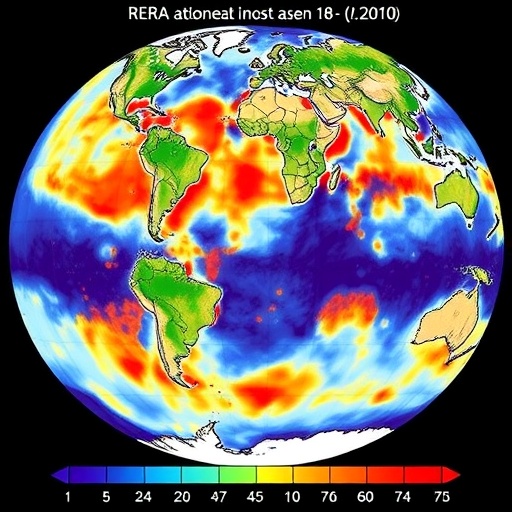Recent research has unveiled intricate spatio-temporal modes of global land surface air temperature variability, utilizing advanced analyses from the ERA5-Land dataset. This comprehensive examination, led by prominent researchers Wei, Yin, Tang, and colleagues, delves into the interplay between spatial patterns and temporal dynamics that govern temperature fluctuations across the globe, providing crucial insights into one of the most pressing issues of our time: climate change.
The study’s significance rests in its thorough examination of ERA5-Land data, which offers high-resolution atmospheric reanalysis. This dataset has proven invaluable in understanding land surface air temperatures, reflecting changes influenced by a plethora of natural and anthropogenic factors. By leveraging this state-of-the-art data, researchers can paint a more accurate picture of how temperature patterns evolve over time, across various regions worldwide.
In their methodology, the researchers employed sophisticated statistical techniques to dissect the variabilities present within land surface air temperatures. They characterized different patterns of temperature fluctuations by applying innovative spatio-temporal analysis, subsequently revealing distinct modes that were previously obscured in more generalized studies. The integration of advanced modeling tools allowed for a more granular exploration, shedding light on temperature trends that can have profound implications for ecological systems and agriculture.
One of the core findings of the study highlights a compelling correlation between temperature variabilities and seasonal cycles. Researchers observed that certain regions exhibit pronounced temperature anomalies during specific seasons, suggesting that climate patterns strongly influence local environments. This realization offers an opportunity for localized strategies addressing the impacts of climate change, enabling better agricultural practices and conservation efforts tailored to the unique challenges faced by different regions.
Additionally, the study keenly underscores the phenomenon of extreme temperature events, which have been steadily increasing in both intensity and frequency across the globe. By identifying and mapping these occurrences through spatial analyses, researchers can equip policymakers and environmental scientists with essential data to devise robust climate adaptation strategies. Understanding when and where these extremes are likely to occur is paramount in preparing for their associated risks.
Furthermore, Wei and colleagues’ research underscores the importance of understanding the interconnectedness of land surface temperatures and other environmental parameters. By analyzing relationships with variables such as precipitation, humidity, and wind patterns, the study illustrates how a multifaceted view of the climate system can lead to better predictions and more effective interventions against the adverse effects of climate change on the environment.
Critical to the study is how it addresses the disparity in temperature variability across different geographical areas. For instance, urban areas tend to experience more pronounced temperature fluctuations than rural locales due to the urban heat island effect. The researchers’ detailed mapping of these disparities illuminates the social and infrastructural challenges that cities face in mitigating the impacts of rising temperatures, emphasizing the need for uniting scientific research with urban planning initiatives.
Moreover, the implications of this research extend beyond academia. The findings carry substantial weight for climate advocacy efforts and can influence public policy. By providing concrete evidence of the trends in temperature variation and their potential implications, stakeholders can better engage communities in climate advocacy, fostering public awareness and promoting sustainable practices.
As climate change continues to challenge global ecosystems and human societies, understanding the nuances of temperature variability becomes ever more vital. The detailed findings of this research pave the way for ongoing studies centered around climate variability. Researchers are now encouraged to build upon this foundational work, exploring more intricate relationships among climatic factors and their resultant effects on ecosystems, agriculture, and human health.
Additionally, this research decisively highlights the role of advanced computational methods in climate science. The application of high-resolution datasets like ERA5-Land combined with cutting-edge analysis techniques has unlocked new dimensions in our comprehension of climate dynamics. As these methodologies continue to evolve, they may provide further insights into predicting future climatic trends, equipping humanity with the knowledge to combat emerging climate challenges more effectively.
As we move forward, integration between diverse disciplines will be paramount in tackling the multifaceted dimensions of climate change. By fostering collaboration between climatologists, ecologists, policymakers, and technologists, actionable frameworks can be developed to mitigate the impacts of temperature variability on both local and global scales. A well-informed dialogue between scientific research and public policy will enable societies to adapt and respond more effectively in face of rising uncertainties.
In summary, the findings from Wei, Yin, Tang, and their team’s rigorous research into global land surface air temperature variability serve as a clarion call to recognize the seriousness of climate change. The detailed exploration of spatio-temporal patterns not only enhances our understanding of climate variability but also signifies a step towards formulating responsive, science-backed strategies to secure a sustainable future. Tackling climate change’s multifaceted challenges requires both collective awareness and decisive action, and this research serves as a critical resource for those at the forefront of this urgent global issue.
In conclusion, as our environments continue to shift with the advancing climate crisis, studies such as this provide necessary frameworks for understanding the phenomena at play. With dedicated efforts and informed strategies derived from these findings, we can work toward mitigating adverse effects and ensuring ecological stability for generations to come. Engaging with this research and its implications will be vital for communities around the world as we collectively address the urgent issue of climate change and its far-reaching impacts.
Subject of Research: Global land surface air temperature variability
Article Title: Spatio-temporal modes of global land surface air temperature variability investigated with ERA5-Land
Article References: Wei, Y., Yin, W., Tang, C. et al. Spatio-temporal modes of global land surface air temperature variability investigated with ERA5-Land. Environ Monit Assess 197, 1240 (2025). https://doi.org/10.1007/s10661-025-14690-3
Image Credits: AI Generated
DOI:
Keywords: Climate Change, Temperature Variability, ERA5-Land Data, Spatio-temporal Analysis, Urban Heat Island Effect, Climate Adaptation Strategies




